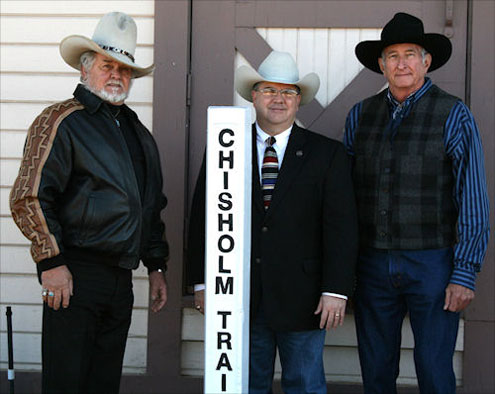Saginaw, Texas is a bustling, urban city. One of the fastest growing spots in the United States. In the morning and afternoon, Main Street boasts traffic jams worthy of a Los Angeles freeway.
Trains rumble past the massive grain elevators several times a day, and planes come in low for a landing at the nearby Meacham International Airport.
But it wasn’t always like that.
In the not-so-distant past, Saginaw was nothing more than a large area of open range over which cattle moved on their way up the Chisholm Trail. It might be hard to imagine a herd of cattle strolling through the city, but facts is facts and that’s our history. Newcomers to Saginaw might not care. But most of us do.
So do Billy Cate and Steve Myers.
Cate and Myers are currently engaged in a project to mark the Chisholm Trail all over Texas. They’ve already marked the trail in several other counties, and Saturday it was Tarrant’s turn.

A small group of people gathered at the Saginaw Chamber of Commerce Building for the dedication of the site marker that now stands proudly just outside its doors.
“In the fall of 1867,” said Cate as he began the dedication speech, “across the plains of Texas, clouds of dust and the thunder of hoof-beats could be heard as a massive exodus begins, as thousands of longhorn cattle head north. Over the next two decades, more than six million longhorns were herded nearly 1,200 miles to stockyards in Kansas in the largest commercial migration of animals in U.S. history."

"This mass migration generated 25 million dollars worth of cattle sales, enough to save Texas from post Civil War economic ruin," Cates continued. "The Texas beef found an eager market in northern cities, where post-war demand was high, and the men who make the fearsome journey became American icons – the cowboy of the West. The route those cowboys traveled became the stuff of legends and stories for decades to come, known around the world as the Chisholm Trail.”
The Chisholm Trail is named for Jesse Chisholm, the man who blazed the way. It’s estimated that somewhere between 25,000 to 35,000 men moved six to 10 million head of cattle, and one million horses up that trail to Kansas between 1867 and 1885.
After Cate finished his short speech, the marker was unveiled to the claps of the appreciative audience and then everyone adjourned out of the cold to have cookies and coffee in the Chamber office.

The marker is a tall, cement pole standing beside a small plaque containing a bit of history for visitors to read. In front of it, a wide brick patio has been laid, every brick bearing the name of someone, or something, here in Saginaw. Truly a wonderful monument to an important part of Saginaw, Texas history.
For more information on the Chisolm Trail or the marking project, please contact Billy Cate at billycate@billycate.com or Steve Myers at yippy-io1876@sbcglobal.net.
